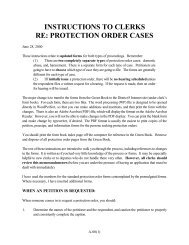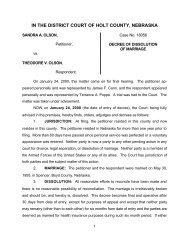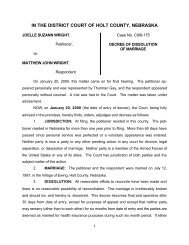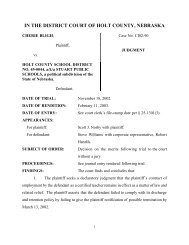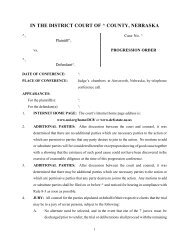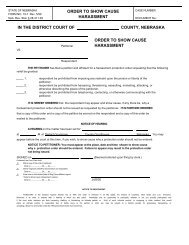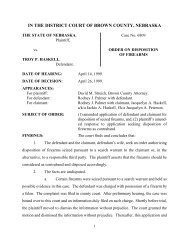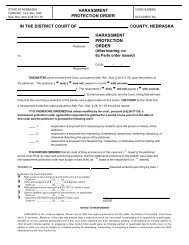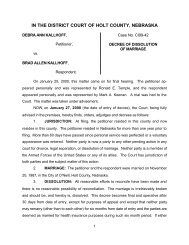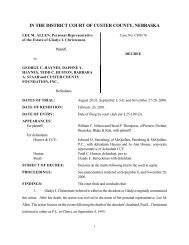State v. Klasna - District Court of Nebraska: Eighth Judicial District
State v. Klasna - District Court of Nebraska: Eighth Judicial District
State v. Klasna - District Court of Nebraska: Eighth Judicial District
You also want an ePaper? Increase the reach of your titles
YUMPU automatically turns print PDFs into web optimized ePapers that Google loves.
IN THE DISTRICT COURT OF BOYD COUNTY, NEBRASKATHE STATE OF NEBRASKA, Case No. 4678vs.Plaintiff-Appellee,JUDGMENT ON APPEALDUANE TIMOTHY KLASNA,Defendant-Appellant.DATE OF HEARING: July 17, 2000.DATE OF RENDITION: July 17, 2000.DATE OF ENTRY: Date <strong>of</strong> filing by court clerk (§ 25-1301(3)).TYPE OF HEARING: Oral arguments on appeal from county court.APPEARANCES:For appellant:Forrest F. Peetz with defendant.For appellee:Carl Schuman, Boyd County Attorney.SUBJECT OF ORDER: Appeal from county court (case number CR99-7).PROCEEDINGS:At the hearing, these proceedings occurred:The bill <strong>of</strong> exceptions, as filed with the clerk <strong>of</strong> this court, is deemed as admitted in evidencepursuant to NEB. REV. STAT. § 25-2733(2) (Reissue 1995). Arguments <strong>of</strong> counsel were heard orwaived. The decision was pronounced.OPINION:1. The appellant appeals from the judgment and sentence <strong>of</strong> the county court upon a plea <strong>of</strong>guilty to the charge <strong>of</strong> driving under suspension.2. Upon appeal from a county court in a criminal case, a district court acts as an intermediateappellate court, rather than as a trial court, and its review is limited to an examination <strong>of</strong> the county courtrecord for error or abuse <strong>of</strong> discretion. <strong>State</strong> v. Hopkins, 7 Neb. App. 895, 587 N.W.2d 408 (1998).Both the district court and a higher appellate court generally review appeals from the county court for errorappearing on the record. <strong>State</strong> v. Patterson, 7 Neb. App. 816, 585 N.W.2d 125 (1998).3. Appellate review is limited to those errors specifically assigned in the appeal to the district1
court and again assigned as error in an appeal to a higher appellate court. Miller v. Brunswick, 253Neb. 141, 571 N.W.2d 245 (1997). Although an appellate court ordinarily considers only those errorsassigned and discussed in the briefs, the appellate court may, at its option, notice plain error. Id. Plainerror exists where there is an error, plainly evident from the record but not complained <strong>of</strong> at trial, whichprejudicially affects a substantial right <strong>of</strong> a litigant and is <strong>of</strong> such a nature that to leave it uncorrected wouldcause a miscarriage <strong>of</strong> justice or result in damage to the integrity, reputation, and fairness <strong>of</strong> the judicialprocess. Id.4. The appellant makes two assignments <strong>of</strong> error in the statement <strong>of</strong> errors. First, theappellant alleges that sentence was excessive. Second, the appellant asserts that period <strong>of</strong> motor vehicleoperator’s license revocation was excessive and in excess <strong>of</strong> statutory authority.5. The defendant was convicted <strong>of</strong> driving during a period <strong>of</strong> suspension under NEB. REV.STAT. § 60-4,108 (Reissue 1998). That section classifies the <strong>of</strong>fense as a Class III misdemeanor.Additionally, for a first <strong>of</strong>fense, it requires that the court order the defendant not to operate any motorvehicle for any purpose for a period <strong>of</strong> one year upon final judgment <strong>of</strong> any appeal or review, and not torun concurrently with any jail term imposed. A Class III misdemeanor provides no statutory minimum andimposes a statutory maximum penalty <strong>of</strong> three months imprisonment or a $500 fine or both. NEB. REV.STAT. § 28-106 (Cum. Supp. 1998).6. A sentence imposed within statutory limits will not be disturbed on appeal absent an abuse<strong>of</strong> discretion by the trial court. <strong>State</strong> v. Hopkins, supra. The power to impose a sentence for thecommission <strong>of</strong> a crime against the <strong>State</strong> is entrusted to the sentencing court and not to an appellate court.Id. An abuse <strong>of</strong> discretion takes place when the sentencing court’s reasons or rulings are clearly untenableand unfairly deprive a litigant <strong>of</strong> a substantial right and a just result. Id. <strong>Court</strong>s are well advised to relyupon the statutory guidelines for imposing sentences. Id. Mitigating considerations are relevant when asentence is appealed as excessive, but only on the question <strong>of</strong> whether the sentencing court abused itsdiscretion and not as justification for a lesser sentence which the appellate court would have imposed. Id.An appellate court may not vacate a sentence <strong>of</strong> imprisonment imposed by a trial court simply because thedefendant possesses redeeming qualities which might lead other trial courts, or the appellate court, torender a more lenient sentence. Id. An appellate court, including a district court reviewing a county court2
sentence, has extremely limited review <strong>of</strong> sentences. Id. A defendant is not entitled to a sentence toprobation as a matter <strong>of</strong> right. <strong>State</strong> v. Swails, 195 Neb. 406, 238 N.W.2d 246 (1976); <strong>State</strong> v.Holiday, 182 Neb. 229, 153 N.W.2d 855 (1967).7. The sentence imposed <strong>of</strong> imprisonment for 60 days is well within the statutory limits anddoes not constitute an abuse <strong>of</strong> discretion. The license suspension <strong>of</strong> one year for a first <strong>of</strong>fense is preciselywhat the statute expressly requires in such circumstances. It does not constitute an abuse <strong>of</strong> discretion.8. This court considers one matter not raised by the appellant. In pronouncing sentence, thecounty court stated: “You’ll be given credit for any time that you’ve spent in jail on this particular <strong>of</strong>fense.And I don’t know if there are – is any time that you’ve spent in jail already for this. Okay. Do you haveany questions?” 4:24-5:3. The findings <strong>of</strong> the written judgment stated: “The <strong>Court</strong> finds that the[d]efendant should be sentenced to 60 days in jail with credit given for any time he may haveserved already, . . .” T7 (emphasis supplied). Thereafter, judgment ordered that “the [d]efendant issentenced to [s]ixty (60) days in jail . . . .” T7. Contrary to NEB. REV. STAT. § 47-503(2) (Reissue1998), the court did not “set forth [such credit] as part <strong>of</strong> the sentence at the time such sentence [was]imposed.”9. Because the appellant did not assign error in this regard, this court only considers the matterif such constitutes plain error. The higher appellate courts have not expressly determined the failure tocomply with § 47-503(2) constitutes plain error. Section 47-503 considers credit for time served upona sentence to a city or county jail. NEB. REV. STAT. § 83-1,106(5)(a) (Reissue 1999) imposes anidentical requirement for sentences to the Department <strong>of</strong> Corrections. In <strong>State</strong> v. Gr<strong>of</strong>f, 247 Neb. 586,529 N.W.2d 55 (1995), the Supreme <strong>Court</strong> characterized the failure to calculate the credit for time servedas plain error. Because the statutory mandates <strong>of</strong> §§ 47-503(2) and 83-1,106(5)(a) are virtually identical,this court concludes that failure to comply with § 47-503(2) also constitutes plain error.10. The circumstances in Gr<strong>of</strong>f were very similar to the present case, in that the trial court inGr<strong>of</strong>f stated “I’m to give you credit for time served” at the conclusion <strong>of</strong> the sentencing hearing, but thecourt’s notes, original commitment order and revised commitment order all failed to calculate the amount.<strong>State</strong> v. Gr<strong>of</strong>f, supra, at 590, 529 N.W.2d at ___.11. In <strong>State</strong> v. Esquivel, 244 Neb. 308, 505 N.W.2d 736 (1993), the Supreme <strong>Court</strong>3
observed that prior to 1988, credit for time served was discretionary except where the maximum sentencewas imposed. See <strong>State</strong> v. Lynch, 215 Neb. 528, 340 N.W.2d 128 (1983). In 1988, the word “shall”was substituted for the word “may” in § 83-1,106(1), which coupled with § 83-1,106(5)(a), requires thesentencing judge in a criminal case to separately determine, state, and grant the amount <strong>of</strong> credit on thedefendant’s sentence to which the defendant is entitled. <strong>State</strong> v. Gr<strong>of</strong>f, supra; <strong>State</strong> v. Esquivel,supra. In 1993, the Legislature adopted the language now codified as § 47-503. 1993 Neb. Laws, L.B.113, § 3. The Legislature obviously modeled that language on § 83-1,106. Consequently, the <strong>Court</strong>’sinterpretations regarding § 83-1,106 may fairly be expected to apply to § 47-503.12. In Gr<strong>of</strong>f, the Supreme <strong>Court</strong> determined that the <strong>Court</strong> <strong>of</strong> Appeals had properly modifiedthe sentences imposed in excess <strong>of</strong> the maximum allowed minimum penalty, but that the <strong>Court</strong> <strong>of</strong> Appealshad failed to order the district court to determine the amount <strong>of</strong> credit for time served to which thedefendant was entitled. The Supreme <strong>Court</strong> affirmed in part, and in part remanded with directions toremand to the district court for a determination <strong>of</strong> the amount <strong>of</strong> credit for time served to which thedefendant was entitled. The present case requires a similar disposition.13. The court therefore concludes that the judgment <strong>of</strong> the county court should be affirmed inpart, and in part remanded with direction to determine the amount <strong>of</strong> credit for time served to which thedefendant is entitled.ORDER:IT IS THEREFORE ORDERED AND ADJUDGED that:1. The judgment <strong>of</strong> the county court is AFFIRMED IN PART, AND IN PARTREMANDED WITH DIRECTION to determine the amount <strong>of</strong> credit for time served to which thedefendant is entitled.2. Costs on appeal are taxed to the defendant-appellant.3. The mandate shall issue as provided by law.4
Signed at Butte, <strong>Nebraska</strong>, on July 17, 2000.DEEMED ENTERED upon filing by court clerk.If checked, the <strong>Court</strong> Clerk shall:: Mail a copy <strong>of</strong> this order to all counsel <strong>of</strong> record and to any pro separties, and deliver a certified copy to county court.Done on ___________, 20____ by _____.: Mail postcard/notice required by § 25-1301.01 within 3 days, stating“Judgment <strong>of</strong> county court AFFIRMED IN PART, AND IN PARTREMANDED WITH DIRECTION.”Done on ___________, 20____ by _____.: If not already done, immediately transcribe trial docket entry dictatedin open court.Done on ___________, 20____ by _____.Mailed to:BY THE COURT:_____________________________William B. Cassel<strong>District</strong> Judge5
THE FOLLOWING DOES NOT CONSTITUTE ANY PORTION OF THE ABOVEJUDGMENT OR ORDER AND IS INCLUDED SOLELY FOR THE CONVE-NIENCE OF THE CLERK OF THE DISTRICT COURT:1. Assuming that the clerk <strong>of</strong> the district court places the file stamp and date upon this order (the “entry” defined by § 25-1301) on Monday, July 17, 2000, the last day for filing notice <strong>of</strong> appeal and depositing docket fee for appeal to the <strong>Nebraska</strong> Count<strong>of</strong> Appeal would be Wednesday, August 16, 2000.2. If further appeal is timely perfected, issuance <strong>of</strong> the mandate <strong>of</strong> this court would await the mandate <strong>of</strong> the higher appellatecourt.3. If no further appeal is timely perfected, within 2 judicial days after expiration <strong>of</strong> time for appeal, § 25-2733(1) requiresthe clerk <strong>of</strong> the district court to issue the mandate and to transmit the mandate to the clerk <strong>of</strong> the county court together with a copy<strong>of</strong> the decision.4. The clerk <strong>of</strong> the district court should be prepared to transmit the mandate on Thursday, August 17, 2000.5. In anticipation, at the clerk’s earliest convenience, the clerk should prepare a draft mandate for review to assure that it isproperly completed as to form. The form is provided in the form book. The space for the district court decision would be filled inas “AFFIRMED IN PART, AND IN PART REMANDED WITH DIRECTION”.6. The mandate should be prepared in two duplicate originals. Both copies would be properly dated as to date <strong>of</strong> issuance,signed by the clerk, and the district court seal affixed.7. One <strong>of</strong> the duplicate originals would be filed in the district court file. It would, <strong>of</strong> course, be file-stamped and docketed.8. The other would be transmitted to county court on the same day that it is issued. The clerk <strong>of</strong> the district court wouldphysically hand carry it to the county court clerk for filing in that court. Attached to the county court copy should be a copy <strong>of</strong>the above judgment or order. That attached copy does not have to be specially certified. The judge realizes that, pursuant to thecourt’s instructions, the district court clerk will have already transmitted a certified copy <strong>of</strong> the judgment or order to the county courtat the time <strong>of</strong> entry. But the statute (§ 25-2733(1)) specifically requires that a copy <strong>of</strong> the decision be attached to the mandate.6



